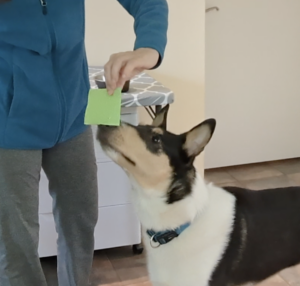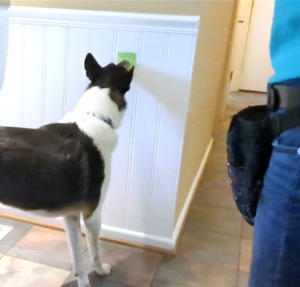Service dogs often need to push different items likes drawers, lights, doors and accessible door buttons to help their handlers. Service dogs are usually trained to push items with their nose, but occasionally the dog may be trained to push with a paw. Targeting with either a nose or a paw is an essential foundation skill for these tasks. Trainers teach the dog to touch a target such as a sticky. Then the sticky is transferred to a drawer, button or whatever the dog ultimately needs to push to execute the finished behavior. When the dog touches the sticky on the door or button regularly, the use of the sticky is faded out. The trainer then differentially marks and rewards when the dog exerts enough pressure on the door or button in order to accomplish the needed task.
Although this process is simple, trainers often make certain mistakes in the process. Here are three common pitfalls to avoid:
- Training the dog to target the trainer’s hand rather than the sticky
The training process typically begins with the trainer holding the sticky and differentially marking and rewarding when the dog touches the sticky. When trainers move through the process too quickly, the dog may end up being trained to target the trainer’s hand rather than the sticky. The key to avoiding this is to precisely mark the desired behavior (touching just the sticky). This can be tricky, because at first the dog will often end up touching both the sticky and the trainer’s hand at the same time. Trainers can strategically hold the sticky in ways that make it easier for the dog to only touch the sticky, but ultimately careful timing when clicking is important, as is increasing criteria incrementally to ensure that the dog is learning to target the sticky.

Another common error can occur after transferring the sticky to the drawer, door or button. Some trainers help the dog too much for too long by using their hand placed next to the sticky. While placing a hand near the sticky can be useful when first changing the location of the sticky, the use of the trainer’s hand to transfer the targeting behavior needs to be faded out completely, as quickly as possible.
- Marking when the dog grabs the sticky with their mouth rather than touching with their nose
Service dogs are commonly trained to retrieve a variety of items. Because so much time is spent teaching the dog to take and hold items with their mouths, service dogs tend to offer mouthing and grabbing of items during training of many different tasks. One way to address this is to experiment with the position of the sticky. For example, holding it high with the top tilted toward the dog may elicit less mouthing than holding it sideways. Another strategy that can help is to click early, as the dog approaches the sticky but before they have a chance to grab it. Lastly, if the dog has been trained to do a chin rest, mixing in a few chin rests during the training process may reduce the mouthing by building some reward history for closed-mouth behaviors.
- Not working toward fluency and generalization
There are so many tasks service dogs need to learn that it is understandable when trainers want to jump right into the needed task. However, since the target as a foundation behavior will be needed for several tasks — most service dogs need to learn to push several different items — spending some extra time working on the foundation targeting behavior saves time over the long run. Items service dogs may need to push can be at a variety of heights and in different locations. Practice by changing the height of the sticky and placing it on different walls and even on furniture. Also, trainers should take the time to change how they are oriented and where they are standing relative to the sticky. Otherwise, the dog may only learn how to approach and touch it when the trainer is in a particular position. Additionally, service dog handlers may need to send the dog out a few feet away from them to push an accessible door button. Incorporate adding some distance when having the dog target the sticky to firm up generalization for this important foundation skill.
It takes extra time to make sure the targeting foundation behavior is clean, fluent and generalized. However, this time is well spent and will shorten the overall training time of a range of tasks that are valuable to clients with disabilities. Setting clear, reasonable criteria, and knowing how to raise criteria at an appropriate rate will result in a clean, useful targeting behavior, and understanding how to generalize it thoroughly will ensure that the service dog can perform a variety of tasks to assist their handler. As always, having a clear understanding from the start of what behaviors your client needs their service dog to perform will help guide your training plan from foundation through finished behaviors.

